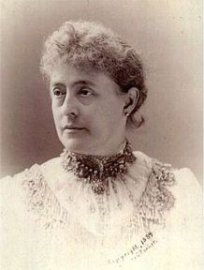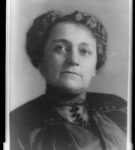Basic Facts:
Birth: August 20, 1833 at North Bend, Ohio
Death: March 13, 1901 at Indianapolis, Indiana of complications from influenza
Married: (1) Caroline Lavinia Scott (1832-1892) on October 20, 1853; (2) Mary Scott Dimmick (1858-1948) on April 6, 1896
Children: 3- (2 with Caroline Scott) – Russell and Mary Scott; (1 with Mary Dimmick): Elizabeth.
President: One term beginning March 4, 1889
Family – Grandfather and Father:
William Henry Harrison was the 9th President of the United States. He and his wife had ten children.
Their fifth child was John Scott Harrison. He married Lucretia Knapp Johnson (1804–1830) and fathered three children. In 1831 he married Elizabeth Ramsey Irwin (1810–1850) and had an additional ten children.
Benjamin Harrison was the second child of John Scott and Elizabeth Irwin Harrison. Benjamin was seven years old when his grandfather was elected president.
In 1878, Benjamin Harrison’s father, John Scott Harrison, died. His body was stolen by grave robbers.
At that time it was common practice for graves to be robbed for recently deceased bodies for use in teaching dissection and anatomy at medical colleges. As a result, many precautions were taken to secure Harrison’s grave, including building a cemented brick vault, filling the grave with earth mixed with heavy stones, and employing a watchman to check the grave each hour of every night for a week.
The day of Harrison’s funeral it was discovered that the body of Augustus Devin, which had been buried the previous week in an adjoining grave, had been stolen. The following day, one of John Harrison’s sons, together with a friend of Devin, traveled to Cincinnati to look for his body. With search warrants in hand they went to the Ohio Medical College, where they discovered not Devin’s body but the naked body of John Scott Harrison hanging from a rope in a chute. Devin’s body was later found preserved in a vat of brine at the medical college of the University of Michigan.
The outrage over the act, amid changing sensibilities regarding death, contributed materially to passage of the Ohio Anatomy Law of 1881, a landmark statute, whereby medical schools were provided with unclaimed bodies, which in turn discouraged grave robbers by removing their primary market.
Family- Wife and Children:
 It was at Farmer’s College near Cincinnati that Benjamin met his future wife, Caroline Lavinia Scott, who was the daughter of his science professor. They married in 1853 and in 1854 they moved to Indiana. The Harrison’s had two children,
It was at Farmer’s College near Cincinnati that Benjamin met his future wife, Caroline Lavinia Scott, who was the daughter of his science professor. They married in 1853 and in 1854 they moved to Indiana. The Harrison’s had two children,
- Russell Benjamin Harrison (August 12, 1854 – December 13, 1936) was a businessman, lawyer, diplomat, and politician
- Mary “Mamie” Scott Harrison (April 3, 1858 – October 28, 1930). Married to James Robert McKee and with two children by the time her father was elected as president, Mary and her family lived at the White House during her father’s term. She assisted by serving as a hostess.
Caroline was First Lady from inauguration day March 4, 1889 until her death in 1892.
 In 1896, Harrison at age 62 remarried, to Mary Scott Lord Dimmick, the widowed 37-year-old niece and former secretary of his deceased wife. Harrison’s two adult children, Russell, 41 years old at the time, and Mary (Mamie) McKee, 38, disapproved of the marriage and did not attend the wedding.
In 1896, Harrison at age 62 remarried, to Mary Scott Lord Dimmick, the widowed 37-year-old niece and former secretary of his deceased wife. Harrison’s two adult children, Russell, 41 years old at the time, and Mary (Mamie) McKee, 38, disapproved of the marriage and did not attend the wedding.
Benjamin and Mary had one child together, Elizabeth (February 21, 1897 – December 26, 1955).Elizabeth Harrison was founder and publisher of Cues on the News, an investment newsletter for women. Her daughter, (granddaughter of Benjamin Harrison), Mary Jane Walker, married Newell Garfield, a grandson of Interior Secretary James Rudolph Garfield, and great-grandson of President James Garfield.
Other
He stood five feet six inches tall, (slightly taller than James Madison, the shortest president) and was called “Little Ben” by his Democratic opponents.
Harrison served in the Senate from March 4, 1881, to March 3, 1887. He was nominated as the party’s presidential candidate on the eighth ballot in 1888.
Harrison’s opponent in the general election was Democrat President Grover Cleveland. The Republicans campaigned heavily in favor of protective tariffs, turning out protectionist voters in the important industrial states of the North. Harrison received 90,000 fewer popular votes than Cleveland, but carried the Electoral College 233 to 168. Allegations were made against Republicans for engaging in irregular ballot practices.
Harrison had made no political bargains, but his supporters had made many pledges on his behalf. When Boss Matthew Quay of Pennsylvania, who was rebuffed for a Cabinet position for his political support during the convention, heard that Harrison ascribed his narrow victory to Providence, Quay exclaimed that Harrison would never know “how close a number of men were compelled to approach…the penitentiary to make him president”.
Harrison was known as the Centennial President because his inauguration celebrated the centenary of the first inauguration of George Washington in 1789.
Grover Cleveland held an umbrella over his successor’s head while Harrison delivered his inaugural address in a rainstorm, said to be the wettest inauguration in history.
Harrison was sworn into office on March 4, 1889. Among the major issues facing his administration were civil service reform, the administration of Civil War pensions and the regulation of tariffs. The spending policies of the federal government during Harrison’s term earned the legislative branch the moniker “the Billion Dollar Congress.”
Benjamin Harrison was the last Civil War general to serve as president of the United States.
Was the last president to have a full beard.
Was the first president to have his voice recorded. You Tube.com
Had electricity installed in the White House. However, he and his wife would not touch the light switches for fear of being electrocuted and often went to bed with the lights left on.
The problems of currency reform and economic equity were also matters that Harrison was compelled to address. As president, Harrison signed the Sherman Antitrust Act into law in an effort to curtail monopolies. The question of monetizing silver also demanded government attention. Although Harrison signed a compromise bill, the controversy over currency continued to rage throughout his presidency. He also attempted, unsuccessfully, to enact legislation protecting and extending the civil rights of Black Americans.
The United States, now past the Civil War, had not resolved its relationship to its Native American inhabitants by the time Harrison had taken office. On December 29, 1890, federal troops clashed with the Sioux at the Battle of Wounded Knee, killing nearly 150 men, women and children. Elsewhere, the federal government continued its aggressive policies of assimilation and acculturation.
In March 1891, Harrison signed a Land Revision Act. This act allowed land to be set apart by the government as a protected reserve. A month after the law had passed, Harrison began creating what are known to us now as National Parks and Nature Reserves.
He authorized the first ever U.S. forest reserve, on land adjacent to Yellowstone Park, Wyoming. During his term he continued this work, and by the time he left office he had protected up to 22 million acres of forest reservations.
One of the lasting legacies of Harrison’s presidency was the expansion of the country to include the states of Montana, Washington, Idaho, Wyoming and the Dakotas.
On November 2, 1889, President Harrison signed the proclamations admitting North and South Dakota to the Union. Due to a rivalry which existed between the two states, Harrison ordered the papers to be shuffled and for the names to be hidden from him while signing so there would be no argument over which he signed first. We don’t actually know which one was signed first because it was never recorded. However, since North Dakota is before South Dakota alphabetically, its proclamation was printed first in the Statutes At Large, thus North Dakota has always been considered the 39th state.
While Harrison became enmeshed in the Hawaiian annexation debate at the end of his presidency, the matter remained open into the 1890s.
Economically, the situation was worsening as the 1892 election approached. Surplus gave way to a deficit as the country spiraled toward financial panic. In 1892, the Democratic Party re-nominated former President Cleveland to run against Harrison. The Republicans were weakened by the defection of Western voters to the Populist Party, which promised free silver and an eight-hour workday.
Benjamin Harrison was running for re-election but did not campaign on his own behalf, choosing to remain by the side of his ailing wife, Caroline, who died in October 1892 of tuberculosis. Two weeks later, former President Cleveland prevailed over incumbent President Harrison in the general election.
The Election of 1892 also gave us another first. It was the first time no candidate campaigned in a presidential election. Cleveland did not actively campaign out of respect to President and Mrs. Harrison.
Benjamin Harrison had defeated the incumbent President Grover Cleveland in the election of 1888. In his bid for re-election in 1892, Harrison was defeated by Cleveland making it the only time an incumbent president was defeated by a former president.
The American President Benjamin Harrison had 2 opossums as pets name Mr. Reciprocity and Mr. Protection
He was reportedly nicknamed the “human iceberg” because of his stiff and formal manner in conversation.
Return to The Presidents main page.
Sources:
Internet Public Library
facts.net
Republican Presidents.net
interesting facts world.com
10 facts about.com
history.com
biography.com
wikipedia.org
You Tube.com- Voice recording of Benjamin Harrison
Greenman, Barbara. The Timeline History of U. S. Presidents and First Ladies. Thunder Bay Press, San Diego, California, 2009.
